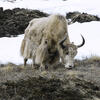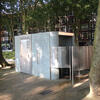You are here
A Mango Harvest with the Baka Pygmies
05.11.2016, by
Deep in the African equatorial forest, the Baka pygmies of Cameroon live in symbiosis with their environment. The anthropologist Laurent Maget joined them during mango harvest season. Depending on the seasons and needs, Pygmies practice hunting, fishing, and gathering.

1
Slideshow mode
Pygmies set up a temporary camp in the forest, northeast of the city of Lomié (Cameroon), in order to harvest the nearby mangoes. This activity can last several weeks. Pygmies are a semi-nomadic people who are becoming increasingly sedentary.
Laurent MAGET / EAE

2
Slideshow mode
The harvest of wild mangoes (Irvinga gabonesis), which consists in picking the ripe fruit off the ground, is an important source of income for Baka pygmies.
Laurent MAGET / EAE / CNRS Photothèque

3
Slideshow mode
Such food gathering is a family activity traditionally carried out by women and children, while the men ensure that the camp remains secure.
Laurent MAGET / EAE / CNRS Photothèque

4
Slideshow mode
The fruits are first split in half with a machete, to recover the flesh and the stones, the kernels.
Laurent MAGET / EAE / CNRS Photothèque

5
Slideshow mode
Rich in fat and proteins, mango kernels are an important food supplement that contains all the amino acids essential to humans.
Laurent MAGET / EAE / CNRS Photothèque

6
Slideshow mode
Once the kernels are extracted, the next step is to peel off the thin film around them.
Laurent MAGET / EAE

7
Slideshow mode
Consumed directly on the site, the fruit pulp is also used to make juice, jam, or jelly.
Laurent MAGET / EAE

8
Slideshow mode
As they are collected, the kernels are taken to nearby villages to be dried or sold. Due to the humidity, long-term storage in the forest would spoil them.
Laurent MAGET / EAE

9
Slideshow mode
The kernels are then placed on a brazier for 24 hours.
Laurent MAGET / EAE / CNRS Photothèque

10
Slideshow mode
This produces roasted kernels. An alternative method—weather permitting— is to let them dry in the sun on the roof of a hut.
Laurent MAGET / EAE / CNRS Photothèque


12
Slideshow mode
The resulting paste is left to dry. On the third day, the mixture is released from the mold. The hard paste will be grated and used as a condiment to prepare meat or fish stews.
Laurent MAGET / EAE / CNRS Photothèque

13
Slideshow mode
Laurent Maget is a filmmaker and anthropologist who works at the laboratoire Éco-anthropologie et ethnobiologie at the Musée de l’Homme in Paris (France). He has been filming the daily lives of pygmies for the past 15 years, in Gabon and Cameroon.
Laurent MAGET / EAE
Explore more
Society
Article
12/02/2025
Article
11/09/2025
Article
10/20/2025
Article
10/15/2025
Article
10/03/2025
Anthropology
Video
01/30/2024
Article
06/30/2023
Article
04/27/2023
Article
03/24/2021
Article
03/09/2021











